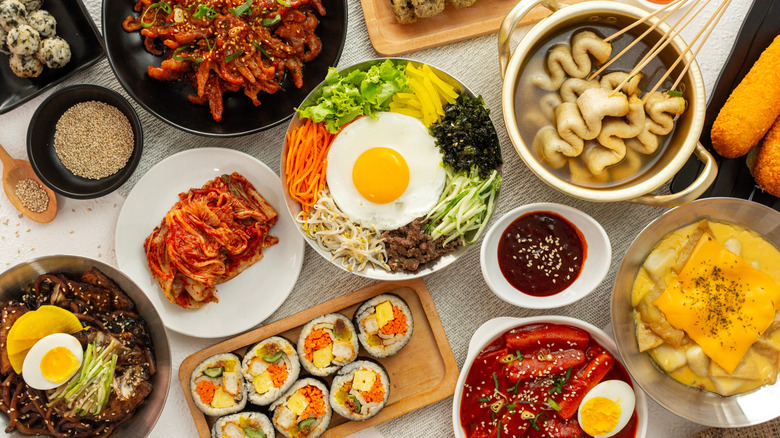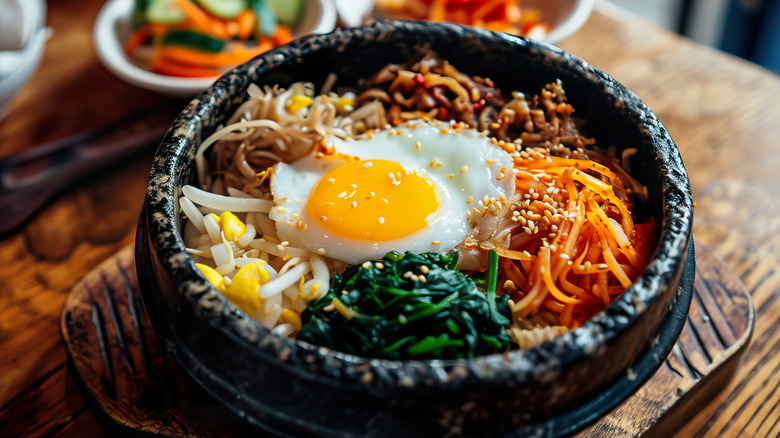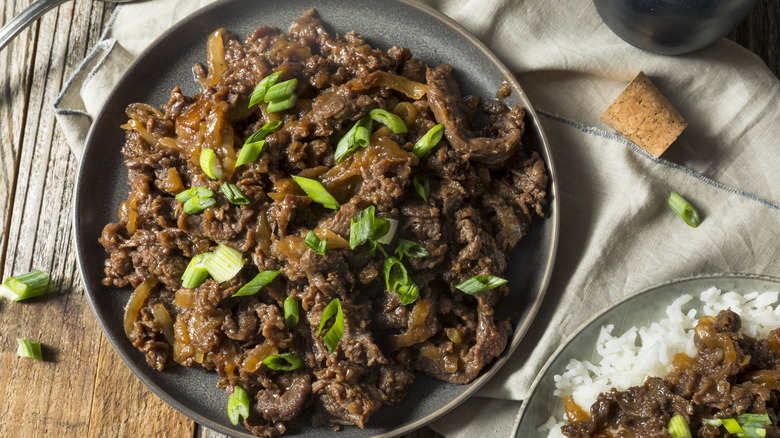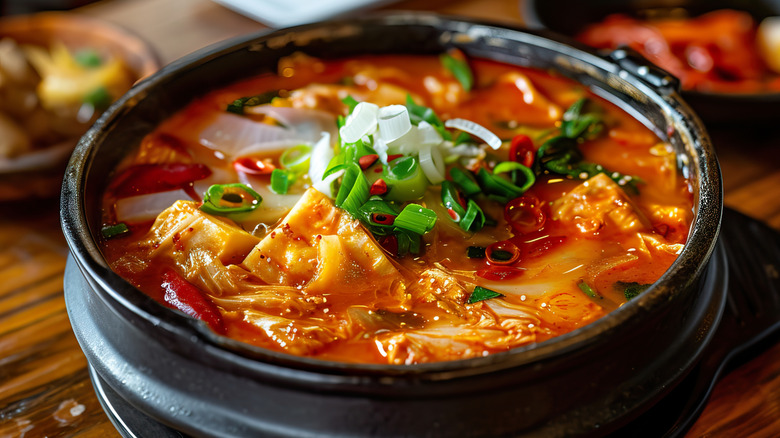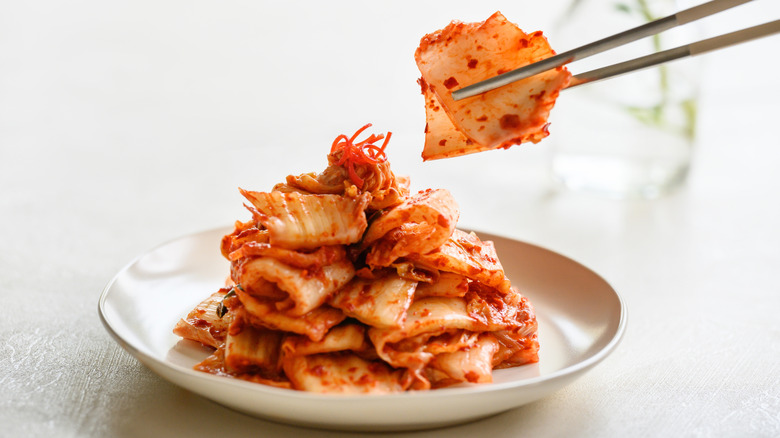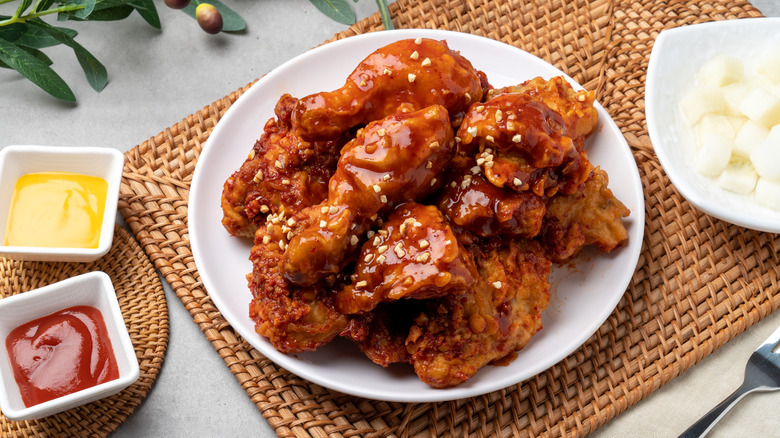Expert Tips To Make Your Favorite Korean Foods Taste Chef-Worthy
We love going out for Korean food for so many reasons: the bold yet balanced flavors, the punchy seasonings, the exciting textures. Like with many types of cuisine, however, whenever we try to recreate that dining experience at home, we somehow miss the mark. While some may say Yondu — a savory seasoning sauce made from fermented and simmered vegetables — is the go-to umami ingredient you need to make homemade Korean food, others have a different secret ingredient for making restaurant-quality Korean food at home. Sungchul Shim, the chef at New York City's Kochi, told Mashed in an exclusive interview that his favored ingredient is fresh-pressed sesame seed oil.
Although sesame oil is pretty common, the version we typically see at the grocery store is unrefined toasted sesame oil. This variety, as the name suggests, is made from toasted sesame seeds and is created with extremely high heat. Cold-pressed sesame oil, on the other hand, requires a gentler process. The crushed seeds are only exposed to heat caused by their own friction, which means the temperature never rises above 48 degrees Fahrenheit.
Shim admitted that fresh-pressed sesame seed oil "may be harder to come by" but it's worth the hunt. He added, "It is not only more flavorful but also full of health benefits." Here's how he suggested leveling up your favorite Korean dishes with fresh-pressed sesame seed oil and other tricks.
Bibimbap
An easy bibimbap recipe typically includes seasonal vegetables, beef or fish, an array of sauces, and a perfectly fried egg atop a bed of white rice. With roots in the Three Kingdom period, the beloved dish was originally served in a heated stone bowl called a dolsot, which is still used today. This causes the rice at the bottom to become delightfully toasted and crispy. Chef Sungchul Shim told us that with cold-pressed sesame oil in your arsenal, you can achieve that same effect at home.
"Use sesame oil generously, and heat your bowl to create a crispy rice layer at the bottom," Shim explained, adding, "The sesame oil adds a rich, nutty flavor, and the crispy rice layer adds texture, similar to the stone bowls (dolsot) used in restaurants." Alternatively, you can crisp up your rice using a skillet. Just coat the bottom of the pan with your special sesame oil, add a thin layer of rice to the pan, and cook it until it's browned and crackling at the bottom.
Bulgogi
We'd guess that bulgogi probably makes the final cut every time you order Korean food. The fan favorite is a Korean barbecue-style beef dish typically made from flavorful cuts like ribeye, sirloin, or tenderloin. The supremely thin slices of beef are flash-cooked on a skillet or grill until medium rare. What stands out most about bulgogi — even more so than its sweet and savory sauce, which is made from soy sauce, honey, garlic, onion, and (if you're lucky) a touch of pear — is the meat's perfect caramelization.
To get that gorgeous golden-brown color and rich flavor, Sungchul Shim told us, "Marinate the meat for at least 24 hours and grill on high heat for a charred, caramelized finish." Your favorite easy bulgogi recipe may tempt you to cut that marination time short, but as Shim explained, this time is key if you truly want restaurant-level bulgogi. "The long marination allows the flavors to fully penetrate the meat, and the high-heat grilling helps to achieve that signature smokiness and crispy edges."
Jjigae
Jjigae is a Korean style of stew that takes comfort food to a whole new level. It can feature a wide variety of ingredients, including meat, tofu, fish, or vegetables, and it's typically flavored with famous Korean condiments like doenjang, ganjang, saeujeot, or gochujang — the latter of which has been enjoying a stint in the cultural spotlight. (If you're not caught up, here's a crash course on what gochujang is and what it tastes like.)
While stews are pretty easy to whip up, only requiring you to simmer ingredients in a tasty broth, chef Sungchul Shim said that in the case of jjigae, you'll want to take the extra time to make quality stock. "Use homemade stock (preferably anchovy or beef bone) and let it simmer for hours to develop deep flavors," Shim said. "Slow-cooking and using homemade stock enriches the broth, giving it a more authentic depth compared to using water or store-bought stock."
Kimchi
If you're a fan of fermented foods, a good homemade kimchi recipe is a must-have. Commonly made with napa cabbage or Korean radishes, kimchi is created via a process called lacto-fermentation. This process (the same one used to make sauerkraut, dill pickles, and yogurt) involves a bacteria called Lactobacillus consuming the sugars present in food and expelling them as sour lactic acid; however, this can only be accomplished in an environment with a controlled temperature, no oxygen (think mason jar), and with the addition of salt. In kimchi's case, the vegetables are typically soaked in brine, drained, seasoned, packed tightly into a jar, and left to ferment.
To ensure you get the most flavorful final product possible, Sungchul Shim advised, "Ferment at room temperature for one to two days before refrigerating." While you can ferment kimchi in the fridge, the process is much slower and, as Shim pointed out, doesn't have quite the same punch. "Room-temperature fermentation allows the kimchi to develop more complexity and acidity, which is key for the vibrant flavor typically found in restaurant kimchi," he told Mashed.
Korean fried chicken
Delightfully crispy and oh-so-succulent, Korean fried chicken became popular after its creation during the Korean war. According to the story, Black soldiers stationed in Korea made the dish in an effort to celebrate Thanksgiving while deployed. These soldiers reportedly went on to teach Korean cooks the art of frying chicken. This rendition is extra crispy and smothered in a tasty sauce made with ketchup, gochujang, garlic, rice syrup, and white vinegar.
To ensure your Korean fried chicken has the same level of crispiness provided by your go-to Korean joint, chef Sungchul Shim suggested, "Double fry the chicken and brush on the sauce after frying." If you haven't tried it before, double frying chicken involves frying the meat one time, allowing the skin to get good and crunchy, removing it from the heat to rest, and then putting it back in the fry oil to cook a second time. As Shim told us, "Double frying ensures a super crispy exterior, while applying the sauce after frying prevents it from becoming soggy and keeps the crunch intact."
